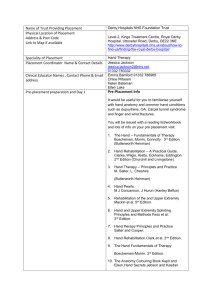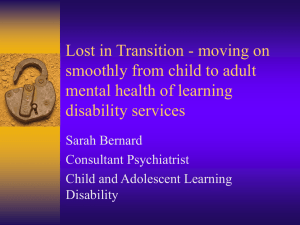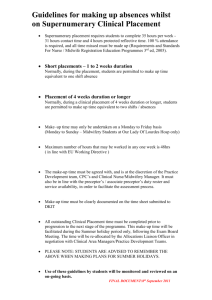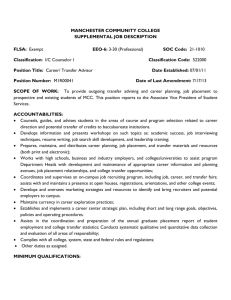section 31: job development and placement fee for service procedures
advertisement
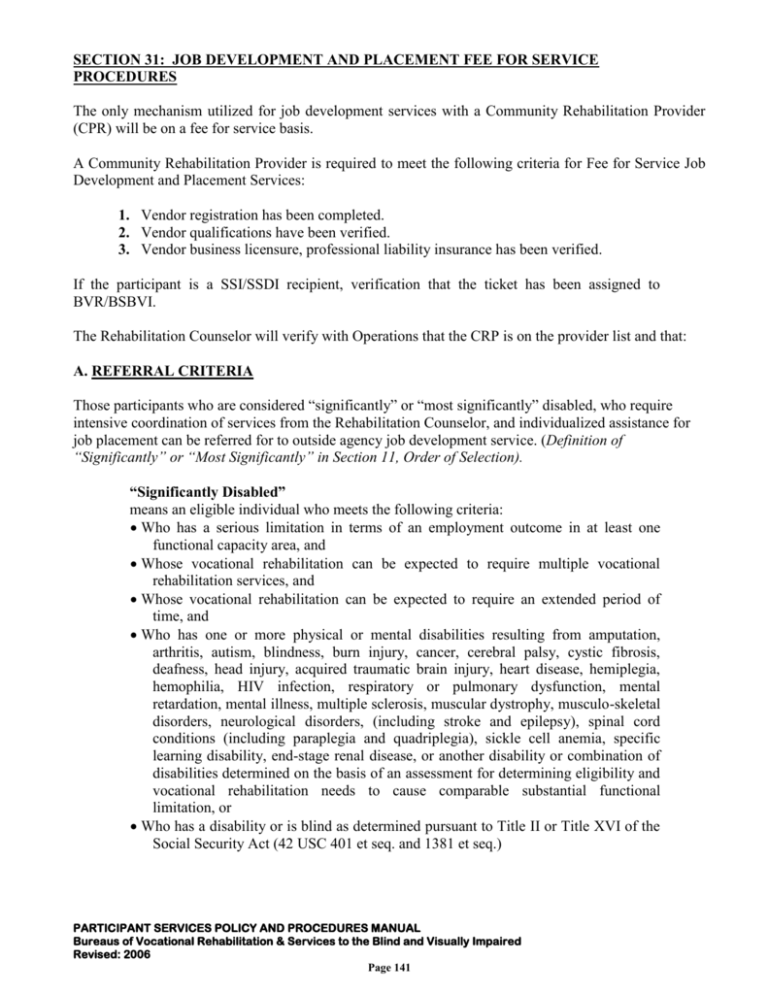
SECTION 31: JOB DEVELOPMENT AND PLACEMENT FEE FOR SERVICE PROCEDURES The only mechanism utilized for job development services with a Community Rehabilitation Provider (CPR) will be on a fee for service basis. A Community Rehabilitation Provider is required to meet the following criteria for Fee for Service Job Development and Placement Services: 1. Vendor registration has been completed. 2. Vendor qualifications have been verified. 3. Vendor business licensure, professional liability insurance has been verified. If the participant is a SSI/SSDI recipient, verification that the ticket has been assigned to BVR/BSBVI. The Rehabilitation Counselor will verify with Operations that the CRP is on the provider list and that: A. REFERRAL CRITERIA Those participants who are considered “significantly” or “most significantly” disabled, who require intensive coordination of services from the Rehabilitation Counselor, and individualized assistance for job placement can be referred for to outside agency job development service. (Definition of “Significantly” or “Most Significantly” in Section 11, Order of Selection). “Significantly Disabled” means an eligible individual who meets the following criteria: Who has a serious limitation in terms of an employment outcome in at least one functional capacity area, and Whose vocational rehabilitation can be expected to require multiple vocational rehabilitation services, and Whose vocational rehabilitation can be expected to require an extended period of time, and Who has one or more physical or mental disabilities resulting from amputation, arthritis, autism, blindness, burn injury, cancer, cerebral palsy, cystic fibrosis, deafness, head injury, acquired traumatic brain injury, heart disease, hemiplegia, hemophilia, HIV infection, respiratory or pulmonary dysfunction, mental retardation, mental illness, multiple sclerosis, muscular dystrophy, musculo-skeletal disorders, neurological disorders, (including stroke and epilepsy), spinal cord conditions (including paraplegia and quadriplegia), sickle cell anemia, specific learning disability, end-stage renal disease, or another disability or combination of disabilities determined on the basis of an assessment for determining eligibility and vocational rehabilitation needs to cause comparable substantial functional limitation, or Who has a disability or is blind as determined pursuant to Title II or Title XVI of the Social Security Act (42 USC 401 et seq. and 1381 et seq.) PARTICIPANT SERVICES POLICY AND PROCEDURES MANUAL Bureaus of Vocational Rehabilitation & Services to the Blind and Visually Impaired Revised: 2006 Page 141 “Most Significantly Disabled” means an eligible individual who meets the following criteria: Who has a serious limitation in terms of an employment outcome in at least four functional capacity areas; and Whose vocational rehabilitation can be expected to require multiple vocational rehabilitation services; and Whose vocational rehabilitation can be expected to require an extended period of time; and Who has one or more physical or mental disabilities resulting from amputation, arthritis, autism, blindness, burn injury, cancer, cerebral palsy, cystic fibrosis, deafness, head injury, acquired traumatic brain injury, heart disease, hemiplegia, hemophilia, HIV infection with clinical evidence of immunosuppression, respiratory or pulmonary dysfunction, mental retardation, mental illness, multiple sclerosis, muscular dystrophy, musculo-skeletal disorders, neurological disorders (including stoke and epilepsy), spinal cord conditions (including paraplegia and quadriplegia), sickle cell anemia, specific learning disability, end-stage renal disease, or another disability or combination of disabilities determined on the basis of an assessment for determining eligibility and vocational rehabilitation needs to cause comparable substantial functional limitation; or Who has a disability or is blind as determined pursuant to Title II or Title XVI of the Social Security Act (42 USC 401 et seq. and 1381 et seq.) and who has a serious limitation in terms of an employment outcome in at least four functional capacity areas, receives disability or blindness payments under title I, II, X, XIV, or XVI of the Social Security Act [42 U.S.C. 301 et seq., 401 et seq., 1201 et seq., 1351 et seq., 1381 et seq.] or receives disability retirement benefits from a governmental agency because of a disability considered permanent under section 221(i) of the Social Security Act (42 U.S.C. 421 (i)). Those participants who are considered “disabled” (“not significantly” or “most significantly”) cannot be referred for an outside agency for job development services unless: 1) Case file documentation is submitted through the supervisor to the district manager which clearly identifies: a) The specific need for specialized, intensive services, and b) Why these services cannot be provided by in-house staff or the Nevada JobConnect. 2) The referral must be pre-approved and noted by the district manager in the case file. (Definition of Not Significantly Disabled in Section 11, Order of Selection) “Not Significant Disability (Disabled)” means an eligible individual who meets the following criteria: Who has no serious limitation in terms of an employment outcome in any functional capacity area; or Who vocational rehabilitation is not expected to require multiple vocational rehabilitation services, or Whose vocational rehabilitation is not expected to require an extended period of time PARTICIPANT SERVICES POLICY AND PROCEDURES MANUAL Bureaus of Vocational Rehabilitation & Services to the Blind and Visually Impaired Revised: 2006 Page 142 B. FEE STRUCTURE (Phase 1): Referral: Review and Accept or Reject Referral w/report & invoice (Phase 2): Placement: Job Development Plan & Verification of Initial Placement Form & invoice (Phase 3): Retention & Monitoring 30 day job retention & monitoring w/report & invoice 60 day job retention & monitoring w/report & invoice 90 day job retention & monitoring w/report & invoice $ 100.00 $ 500.00 $ 400.00 $ 300.00 $ 700.00 $2,000.00 $2,000 is the maximum amount payable for a competitive job placement. A counselor can negotiate a lower payable rate with a vendor. 1. Job Development & Placement Where the Job Developer Becomes the Employer Under certain circumstances it may be beneficial and acceptable to the Participant, the Bureau and the Job Developer if the Job Developer has the Participant hired as a permanent employee. As with any other decision regarding the IPE and the associated Participant services, the best interests of the Participant and compliance with the IPE must remain in focus. Two fee options exist where the Job Developer becomes the potential employer: 1.a. Bureau initiates placement contact with Job Developer When the Counselor initiates the placement contact with the Job Developer or Job Development & Placement organization, the counselor must ascertain that the placement is appropriate and in the best interest of the Participant and in accordance with the IPE. If so, the counselor may authorize placement services according to the existing fee schedule. 1.b. Job Developer/Job Development & Placement Organization Initiates Placement Request When the placement request is initiated by the Job Developer or Job Development & Placement Organization for a job within that organization, the counselor must ascertain that the placement is appropriate, in the best interest of the Participant and in accordance with the IPE. If so, the counselor will authorize placement fees from the existing fee schedule and limited to referral and initial placement. 2. Other Needed Services Identified during Job Development & Placement Process As determined necessary, appropriate and in the best interest of the Participant and the employer, and in accordance with the IPE, the counselor may authorize (in separate authorizations for each service) additional services for the Participant, as part of the IPE and not covered under the Job Development & Placement Fee Schedule. Such services might include, as appropriate: Job Coaching Community Based Assessment Additional Supervision Other On-The-Job Training services. PARTICIPANT SERVICES POLICY AND PROCEDURES MANUAL Bureaus of Vocational Rehabilitation & Services to the Blind and Visually Impaired Revised: 2006 Page 143 Where any of the other needed services above have a duration of more than 10 days, the balance of the initial authorization for Job Development & Placement Services is to be closed, and the additional services are to be funded separate from the Job Development & Placement activity. The initial development/placement authorization will remain closed until completion of the additional support services. This practice will not interfere with the counselor’s requirement for retaining employment for 90 days. It will, however, extend the vendor’s job retention benchmarks of 30, 60 & 90 days by a number of days equal to the time allocated to the additional services funded. It is the intent of this policy that Phase 3 of the Job Development & Placement process and non-Job Development & Placement processes such as community-based assessments not run simultaneously. 2.a. Job Coaching - agreement must be reached regarding the level of Job Coaching required by the Participant and the coaching/supervision ratio in the given job setting. Payment for Job Coaching services shall be calculated at the established rate of $23.50 per hour at the ratio of 1 coach to 1 participant (1:1 = $23.50/hour). A job coach cannot bill for the hourly rate for more than 1 individual for any given time period. 2.b. Community Based Assessment - Counselor will determine the length of time and hours for the assessment and authorize payment of participant wages. 2.c. Additional Supervision & OJT expenses - should be provided in compliance with On-the-Job Training Participant Services Policy and Procedures. Additional supervision payment shall be calculated at the supervisor's hourly rate of pay divided by the number of individuals being supervised. The hourly wage amount and number of employees that individual supervises will be documented by the provider organization and subject to verification by the Rehabilitation in a review of provider wage and position information records. The above policies will apply at any point during the normal Job Development & Placement process if the Job Development & Placement Organization desires to place the Participant in a job in their own organization. 3. CBA or OJT location developed by the Job Developer/Job Development & Placement Organization. The counselor may elect to use a Job Developer for the creation of or location of a Community Based Assessment or On the Job Training site in the community that is unique and specific to the individual needs of the participant if appropriate and in the best interest of the Participant and in accordance with the IPE. Use of the Job Developer for this purpose is seen as expanding the potential range for the development of CBA/OJT sites in the community. The following guidelines are to be followed: 3.a. Where development of a CBA or OJT site is independent of a Job Development & Placement activity, the counselor must: PARTICIPANT SERVICES POLICY AND PROCEDURES MANUAL Bureaus of Vocational Rehabilitation & Services to the Blind and Visually Impaired Revised: 2006 Page 144 3.a.1. Obtain supervisory approval for utilization of the job developer in this manner, 3.a.2. Make certain that the Evaluation Services unit is able to provide the assessment component of the CBA in a reasonable timeframe (Rural Counselors should make other arrangements for completion of the assessment), 3.a.3. Insure that the Job Developer will initiate contact with the potential CBA/OJT site and attend a meeting between the employer, evaluator, Participant and counselor to establish the framework for the CBA/OJT. 3.b. The counselor would authorize a $350 payment to the Job Developer for this service, ($100 - referral and intake, $250 for developing the location and establishing the framework for the service.) This fee would be paid for each site developed and utilized, specific to a participant's individual need. 3.c. Where the CBA/OJT development leads to a placement service, the Job Developer would have the first right of refusal regarding assignment of the Job Development & Placement follow up retention and monitoring. 3.c.1. If the Job Developer accepts the placement assignment, the counselor will authorize an additional $250 to compensate the developer up to the maximum allowed for the first two phases of the standard Job Development & Placement process. 3.c.2. The Job Developer will provide Retention and Monitoring services as outlined in the Job Development and Placement policies. C. REPORTING REQUIREMENTS & DEFINITIONS Referral (Phase 1) Procedure for Review and Rejection of Referral The Community Rehabilitation Provider has received from the referring Rehabilitation Counselor a) an “Authorization”, b) a “Job Readiness Referral Form for Job Development & Placement Services” and attachments c) “Job Development Plan” form d) “Verification of Initial Placement” form The Community Rehabilitation Provider a) has reviewed referral information b) met with the client c) has rejected the referral d) has submitted to the Rehabilitation Counselor and Supervisor, a written report documenting the rejection which includes: e) 1) initial assessment of job readiness 2) client barriers preventing job readiness 3) additional job seeking skills training needs of the client 4) why or why not the vocational goal is or is not achievable has submitted an invoice PARTICIPANT SERVICES POLICY AND PROCEDURES MANUAL Bureaus of Vocational Rehabilitation & Services to the Blind and Visually Impaired Revised: 2006 Page 145 Procedure for Review and Acceptance of Referral The Community Rehabilitation Provider has received from the referring Rehabilitation Counselor a) an “Authorization”, b) a “ Job Readiness Referral Form for Job Development & Placement Services” and attachments c) “Job Development Plan” form d) reporting guidelines e) “Verification of Initial Placement” form The Community Rehabilitation Provider a) has reviewed referral information b) met with the client c) has accepted the referral d) has submitted a written report 1) documenting the acceptance of the fee schedule and reporting requirements 2) initial assessment of job readiness 3) need for additional referral information from the rehabilitation counselor 4) readiness to write and implement the “Job Development Plan” within 10 working days of the date of referral e) has submitted an invoice Procedure for Extension (No additional fees are paid for extension activity) The Community Rehabilitation Provider has submitted to the Rehabilitation Counselor: a) the completed & implemented Job Development Plan b) documentation of the results of job development efforts and placement barriers c) modifications to the Job Development plan to mitigate placement barriers d) written request for extension, specifying extension length e) has received written approval from the Rehabilitation Counselor for the extension Placement (Phase 2) The Community Rehabilitation Provider has submitted an invoice and written, implemented and forwarded a copy of the “Job Development Plan” to the referring Vocational Rehabilitation Counselor. The “Verification of Initial Placement” form has been submitted with Rehabilitation Counselor approval within 45 days** of acceptance of referral. Retention & Monitoring (Phase 3) The Community Rehabilitation Provider has provided: a) an invoice and written documentation that the Client has retained job for 30 days, to include: 1) client satisfaction with the job 2) employer satisfaction with the client’s work performance 3) verification of hours worked and wages paid 4) need for accommodation or other individualized assistance to facilitate employment stability b) an invoice and written documentation that the Client has retained job for 60 days, to include the same report requirements noted in a) above; c) an invoice and written documentation that the Client has retained job for 90 days, to include the same report requirements noted in a) above. PARTICIPANT SERVICES POLICY AND PROCEDURES MANUAL Bureaus of Vocational Rehabilitation & Services to the Blind and Visually Impaired Revised: 2006 Page 146 D. AUTHORIZATION: 1. The authorizations will be a three-phased authorization using the phases above, clearly identifying each payment phase and will be completed for each phase. If the referral is accepted, the total and cumulative amount paid for all three phases combined, regardless of SFY cannot exceed $2000. If an authorization spans two fiscal years, the new fiscal year authorization must clearly reflect only those services not rendered in the previous fiscal year. For example, if “Referral (Phase I)” were all that was completed on the initial authorization, the new authorization for the next fiscal year would not have a reference to Phase I or the dollar amount. Phase Extensions: No additional fees are paid for extension activity. The Rehabilitation Counselor must provide written approval to the CRP for the extension. PARTICIPANT SERVICES POLICY AND PROCEDURES MANUAL Bureaus of Vocational Rehabilitation & Services to the Blind and Visually Impaired Revised: 2006 Page 147
